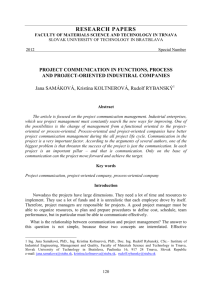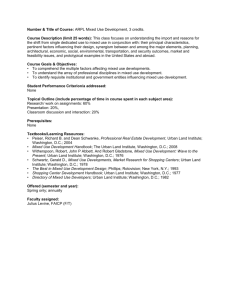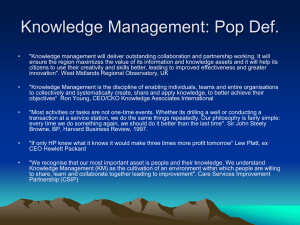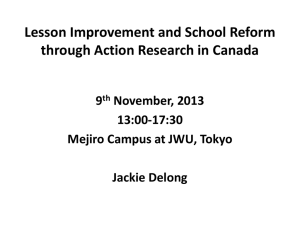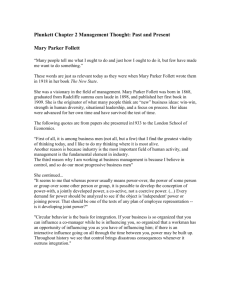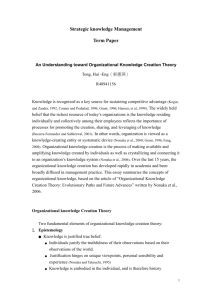Knowledge Management in Project-Oriented Organizations Abstract
advertisement
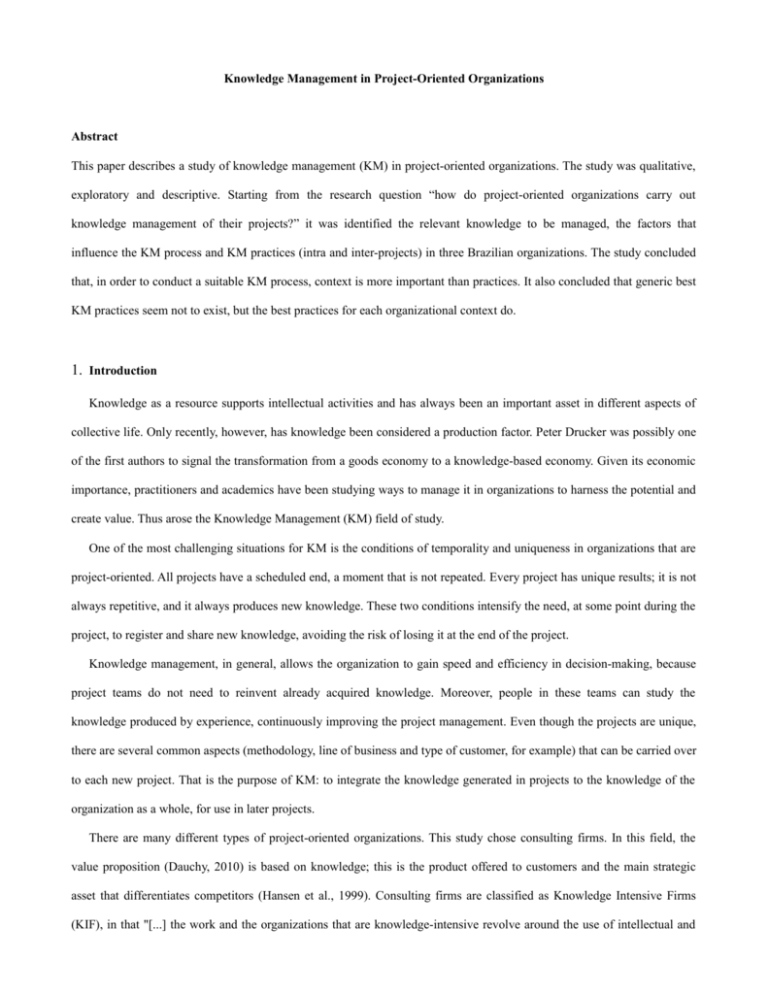
Knowledge Management in Project-Oriented Organizations Abstract This paper describes a study of knowledge management (KM) in project-oriented organizations. The study was qualitative, exploratory and descriptive. Starting from the research question “how do project-oriented organizations carry out knowledge management of their projects?” it was identified the relevant knowledge to be managed, the factors that influence the KM process and KM practices (intra and inter-projects) in three Brazilian organizations. The study concluded that, in order to conduct a suitable KM process, context is more important than practices. It also concluded that generic best KM practices seem not to exist, but the best practices for each organizational context do. 1. Introduction Knowledge as a resource supports intellectual activities and has always been an important asset in different aspects of collective life. Only recently, however, has knowledge been considered a production factor. Peter Drucker was possibly one of the first authors to signal the transformation from a goods economy to a knowledge-based economy. Given its economic importance, practitioners and academics have been studying ways to manage it in organizations to harness the potential and create value. Thus arose the Knowledge Management (KM) field of study. One of the most challenging situations for KM is the conditions of temporality and uniqueness in organizations that are project-oriented. All projects have a scheduled end, a moment that is not repeated. Every project has unique results; it is not always repetitive, and it always produces new knowledge. These two conditions intensify the need, at some point during the project, to register and share new knowledge, avoiding the risk of losing it at the end of the project. Knowledge management, in general, allows the organization to gain speed and efficiency in decision-making, because project teams do not need to reinvent already acquired knowledge. Moreover, people in these teams can study the knowledge produced by experience, continuously improving the project management. Even though the projects are unique, there are several common aspects (methodology, line of business and type of customer, for example) that can be carried over to each new project. That is the purpose of KM: to integrate the knowledge generated in projects to the knowledge of the organization as a whole, for use in later projects. There are many different types of project-oriented organizations. This study chose consulting firms. In this field, the value proposition (Dauchy, 2010) is based on knowledge; this is the product offered to customers and the main strategic asset that differentiates competitors (Hansen et al., 1999). Consulting firms are classified as Knowledge Intensive Firms (KIF), in that "[...] the work and the organizations that are knowledge-intensive revolve around the use of intellectual and analytical tasks [...] requiring extensive theoretical education and experience to be conducted successfully." (Alvesson, 2004, p. 1). Besides temporality and uniqueness, knowledge management provides another important challenge for consulting firms: the use of time. In this line of business, professionals generate invoiced revenue when they are allocated, i.e., when they provide service to a customer. Therefore, as soon as a consultant finalizes a project, he/she should already start the next, to ensure invoiced revenue. Often there is no time for reflection, recording and sharing of acquired knowledge. How do consulting firms deal with this dilemma? Overall, how do project-oriented organizations carry out knowledge management of their projects? This is the research question of this study, which has three specific objectives: (1) to catalog the knowledge relevant to project delivery, (2) to evaluate the factors that influence the practice of knowledge management and (3) to analyze the most used knowledge management practices. The study aimed to investigate how knowledge management and project management processes can interact productively in project-oriented organizations. The expectation is to add knowledge in Project Knowledge Management (PKM), a field of study that integrates the two domains (Hanisch et al., 2009). 2. Theoretical Reference 2.1. Knowledge Defining knowledge is not a simple task. Grant (1996, p. 110) evaluates the difficulty: "What is knowledge? Since this question has intrigued some of the world's greatest thinkers, from Plato to Popper, without the emergence of a clear consensus, this is not an arena in which I choose to compete." Nonaka and Takeuchi bring the concept of knowledge as "justified true belief", which according to the authors was introduced by Plato (Nonaka, Takeuchi, 1997, p. 24). However, these authors emphasize that traditional Western epistemology focused on truth as an essential attribute of knowledge, while they highlight the nature of knowledge as justified belief, a dynamic human process of justifying personal belief with regard to the 'truth' (ibid. p. 63). Knowledge can be considered a strategic asset of the company. This concept is associated with the Knowledge-Based Company Vision or Knowledge-Based View of the firm (KBV). For knowledge to be truly strategic, the organization must be able to access and integrate its employees' specialized knowledge (Grant, 1966). 2.2. Knowledge Management According to Takeuchi and Nonaka (2008), Knowledge Management can be expressed as follows: Knowledge management - defined as the process of continually creating new knowledge, disseminating it widely throughout the organization and rapidly incorporating it into products/services, technology and systems - perpetuates change within the organization. (Ibid., p. I). The process of knowledge management can be influenced by many factors, which can act both as facilitators and complicators, depending on how you configure the organization. For example, the organizational structure can be a facilitator (flexible structure) or complicator (hierarchical). Therefore, this study adopts the neutral term influencers. Influencing factors consolidated Strategy / senior management support Culture / environment Structure / papers Processes / technology Individual factors Literature Nonaka, Takeuchi, 1997; Von Krogh et al., 2001; Koskinen; Pihlanto, 2008; Joia; Lemos, 2010; Chiri; Klobas, 2010. Nonaka, Takeuchi, 1997; Von Krogh et al., 2001; Prencipe et al., 2005; Koskinen; Pihlanto, 2008; Joia; Lemos, 2010; Chiri; Klobas, 2010 Nonaka, Takeuchi, 1997; Von Krogh et al., 2001; Prencipe et al., 2005; Koskinen; Pihlanto, 2008; Joia; Lemos, 2010 Nonaka, Takeuchi, 1997; Von Krogh et al., 2001; Prencipe et al., 2005. Nonaka, Takeuchi, 1997; Von Krogh et al., 2001; Koskinen; Pihlanto, 2008; Chiri; Klobas, 2010. Figure 1 - Factors influencing KM In addition to influencing factors, knowledge management is studied from the perspective of practices in each project (intra-project) and in all the projects (inter-project). For example (Kotnour, 2000; Lício, 2005; Hanisch et al. , 2009; Prencipe et al., 2005; Taminiau et al., 2009): • Intra-project practices: identification and recording of best practices, consulting finished-project data, evaluation of project ideas based on experience, identification and analysis of lessons learned. • Inter-project practices: training new people on teams, assessing synergies in parallel projects, inter-project meetings, practice communities, study groups. 2.3. KM in project-oriented organizations There are various names for the organization geared towards projects: project-oriented, project-based, structured by projects, among others. According to PMI (2008, p. 30), most of the project-oriented organization's resources are involved in project work, and project managers enjoy considerable independence and authority. Project-oriented organizations have departments, but report directly to the project managers or provide support services to the various projects. For Anselmo (2009, p. 34) there are two main concepts of this kind of organization. The first is that the project-oriented organization is one that is structured deliberately around projects, whether internal or sold to the organization's clients. Thus, the internal organizational structure is a result of a strategic choice and not of business necessity. The second is that the project-oriented organization is one that depends mainly on selling projects: the structure, then, is a business requirement. In this study, we observed the knowledge management practices in project-oriented structures, regardless of the reason for being geared towards projects. Project-oriented organizations have challenges in management of their knowledge, which arise from the nature of their activities. This aspect is discussed by Pinto (2005, p. Xi), who asks: "How can we institutionalize and make these practices systematic, when by its very nature, project management represents a unique undertaking, one that is not long-term-process driven, but in every sense temporary?" Singularity and temporality, as indicated by the author, are essential to understanding the difficulty of managing knowledge in project-oriented organizations. Temporality means beginning and end defined: the project necessarily ends at some point, even if it takes years. Cologne Cathedral took 600 years to be built and is constantly being renovated. The uniqueness is related to the creation of product, service or exclusive result. It's possible that some elements are repetitive (some team members, processes, materials), but that does not change a project's unique nature. This aspect differs from activities related to the operation of a company that has a constant repetition of elements, such as an assembly line or a routine within a functional area. Figure 2 details the challenges of the project's nature (temporary and unique) for KM: Temporality Uniqueness Retention difficulty: projects are unable to retain new ideas (they have no memory) because they Low replication: because they are unique, they do have routines and organizational structures that not have the benefit of repetition (learning curve may lead to fragmentation of organizational concept). knowledge. Inefficiency: if they cannot take advantage of New relationships: people meet for a specific previously generated knowledge, organizations project and then separate, making it difficult to have to create solutions for each problem. continue learning. Figure 2 - Challenges of project nature for knowledge management Source: adapted from Koskinen; Pihlanto, 2008; Love et al., 2005; Turner, 2005. Other authors reinforce this argument. For example, Hanisch et al. (2009, p. 150) indicate that temporality and uniqueness are major obstacles to organizational learning in environments geared towards projects, as the importance of processes that ensure knowledge of projects for the company as a whole is obvious. Pihlanto and Koskinen (2008) base their work on several authors, in order to add some vulnerabilities of project-oriented companies: failure to bring development and learning into the organizational context, difficulty in connecting projects to the organization's business processes, lack of time for reflection during project implementation due to overly optimistic schedules and constant lack of resources, meeting of people with highly specialized skills hindering the establishment of a common knowledge base. Specifically in the consulting sector organizations, which are oriented towards projects, as this business requires, this phenomenon is perceived due to invoice revenue being based on the allocation of its professionals (sale of working hours to clients). Once a project is completed, the consultant is transferred to the next project. According to Lício (2005), in the consulting business, the price of the solutions is established in by hours worked, and any activity not linked to counseling services consumes the resources available to generate revenue and should be considered as a cost (or investment). It is within this context that the difficulties of KM processes should be directed; reflect on what has been learned, register for future use, disseminate to others in the organization. People in the organization must be willing to invest their time in this direction, to take advantage of the potential benefits of KM. 3. Method 3.1. Study description The study reported in this work was qualitative, exploratory and descriptive. The case study method was used (Yin, 2010). The conceptual model demonstrates the relationships between the study components and appears in Figure 3. In essence, the conceptual model depicts the transit of knowledge among projects and the organization, within the context of the influencing factors. INFLUENCING FACTORS PROJECTS INTRA-PROJECTPRACTICES Recovery Sharing Storage G D E L W O N K Creationand Acquisition G D E L W O N K S R O T C LF A U V D IN INTER-PROJECTPRACTICES A E /IM Y G R O P U S T N ORGANIZATION CULTURE/ ENVIRONMENT STRUCTURE/ ROLES PROCESSES/ TECHNOLOGY Figure 3 - Conceptual model of the study The main concepts used to formulate this conceptual model were: knowledge management, organization geared towards projects, intra- and inter-project practices and influencing factors. • The definition used for Knowledge Management was suggested by Nonaka and Takeuchi (2008, p. I) who state that it is "the process of continually creating new knowledge, disseminating it widely throughout the organization and incorporating it quickly in products/services, technologies and systems." This process was segmented into recovery, creation/acquisition, and storage and sharing, following the proposal of Fleury and Fleury (2004). • Project was understood as "a temporary endeavor undertaken to create a product, service or exclusive result." (PMI, 2008, p. 5). • Project-oriented organizations are those where most resources are used in the project work and project managers enjoy considerable independence and authority (PMI, 2008, p. 30). • Practices were defined as "professional or management activities that contribute to the execution of a process and that may employ one or more techniques or tools." (PMI, 2008, p. 439). Practices were segmented into intra- (within the scope of a project) and inter-project (combination and sharing of lessons learned in projects), as proposed by Kotnour (2000). • Finally, the influencing factors sought to include the various nomenclatures for this concept: "enabling conditions" (Nonaka, Takeuchi, 1997), "knowledge enablers" and "organizational barriers" (Von Krogh et al., 2001), "conditions for learning evolution" (Prencipe et al., 2005), "factors affecting knowledge sharing" (Koskinen; Pihlanto, 2008). 3.2. Case studies The organizations selected for this study were: (1) project-oriented and of Brazilian origin, (2) ones that provide consulting services (internal or external), (3) ones that belong to different sectors and (4) references in their industries. Based on these criteria, three organizations were chosen for study: Project Management Office of the Central Bank of Brazil, Cia de Talentos (recruitment and selection company) and PromonLogicalis (IT company). The description of each case follows in the next section. In each of these organizations, the respondents were chosen based on two criteria: (1) the respondent should have been working in the organization for at least one year so he/she would have an experienced vision of the organizational reality, and (2) respondents were to be nominated by the organization's own senior people. 3.3. Collecting and analyzing data To collect the data, a case study protocol was prepared. The protocol included the following fields: initial procedures (study identification data, basic data characterizing the organizations, criteria for choosing the organizations, criteria for the interview, number of interviews, possible sources of evidence), field work, script of questions, plan for data analysis and a guide for report preparation. These fields are based on suggestions made by Gil (2009) and Yin (2010). Based on the protocol, preliminary interviews were conducted with two employees of a consulting firm (not from the case studies) to assess whether the study objective was clear, if the script contemplated the main topics that could be explored on the theme and even, if the topic was relevant to the organization. These interviews revealed the need for the respondents to know what kind of knowledge would be analyzed. It was decided that the knowledge to be studied would be related to processes of knowledge retrieval, creation, sharing and storing. Data collection involved an initial conversation with a person from senior management of the chosen companies. This person provided an overview of the company, enabling identification of areas that should be analyzed and possible people to be interviewed. Next, interviews were scheduled by e-mail with the people who were indicated. The actual data collection was conducted through interviews, direct observation and document analysis. Then the case was drawn up and sent to each of the respondents to evaluate and make any adjustments. Upon completion and validation of the three case studies, an integrated analysis was performed. To analyze the cases, we used the technique of content analysis. Content analysis uses systematic and objective procedures of description of the message and indicator content (quantitative or otherwise) that allow for inferring the knowledge relative to the production/reception conditions (inferred variables) of these messages (Bardin, 2008, p. 44). We performed a text pre-analysis, followed by exploration of the material, and finally the categorized data and the results were obtained through inference, by way of the analytical tool depicted in Figure 4. “AAA” identifies a type of relevant knowledge, for example, “technical knowledge”; the column “number” indicates how many times this knowledge was mentioned; “aaa” reveals how the knowledge was mentioned in the interview; “x” shows which respondents mentioned this knowledge. Letter C B D A Name Respondent 1 Respondent 2 Respondent 3 Respondent 4 Relevant Knowldege Nº Trechos AAA 4 "aaaa" / "aaa" / "aa" / "a" BBB 1 "b" CCC 3 "xxx" / "xx" / "x" DDD 1 "y" EEE 2 "ee" / "e" FFF 1 "f" GGG 3 "ggg" / "gg" / "g" HHH 2 "hh" / "h" III 4 "iiii" / "iii" / "ii" / "i" JJJ 3 "jjj" / "jj" / "j" x x x x x x x Facilitating factors x Complicating factors x x x Practices Intra-project x x x x x x x x x x Inter-projects x x Figure 4 – Schematic representation of content analysis 4. Analysis of Results This part of the paper briefly presents the individual case studies (Central Bank of Brazil, Cia de Talentos and PromonLogicalis) and then the integrated case analyses. 4.1. Case Study: PMO Central Bank of Brazil The Central Bank is a federal agency whose mission is to ensure the stability of the currency's purchasing power and a sound and efficient financial system. It was established in 1964 and gradually took on new roles to become the "bank of banks" in Brazil. Today it has about 4,500 employees distributed in a matrix structure. In March 2004, the Corporate Project Management Office (PMO) was established as internal consulting, with funding from the National Monetary Council (CMN) and with the mission to develop the Central Bank through projects. Some tens of millions of Brazilian reals are destined annually for this purpose, which allows for carrying out an average of 80 corporate projects concurrently (with a normal duration of about two years each). The PMO has 12 employees. Beyond the Corporate PMO, there are three sectorial PMOs to support project management in some bank departments. 4.2. Case Study: Cia de Talentos Cia de Talentos (CT), which belongs to the DMRH group, is a recruiting company that selects trainees and interns. This group began in 1988 with the founding of DM (Decision Making), a consultancy specializing in the recruitment and selection of managers and senior executives. Cia de Talentos currently has about 100 employees. Projects last about five months and are very similar in terms of process. 4.3. Case Study: PromonLogicalis PromonLogicalis is an organization of the Promon group and operates in the sector of information technology and communication. It began in 1960. It went through a crisis beginning in 1963 - closely related to the economic scenario in Brazil at the time - and a group of 11 officers and employees united to take it over. PromonLogicalis is the leading independent integrator of solutions for Information Technology and Communication in Latin America. It serves the operational chain of telecom operators (mobile, fixed and cable TV), as well as the technological demands of the corporate and government markets. It has about 600 employees, mostly dedicated to projects. The average duration of the projects is four months, and there are eight main types of methodologies offered to customers. 4.4. Integrated Analysis of Case Studies A total of 27 people were interviewed: eight at the Central Bank, 12 in Cia de Talentos and seven in PromonLogicalis. Twenty-five of these respondents analyzed and commented on the first version of cases, contributing to the preparation of the final case. On average, respondents had 10.7 years in-house, and most of these more than six years. The recorded interviews totaled 30 hours and 33 minutes. All were transcribed, resulting in 192 pages (Times New Roman font, size 12, 1.5 line spacing). 4.4.1. Relevant knowledge In response to the first specific goal of this study - to catalog the knowledge relevant to project delivery – it was possible to identify eight types of knowledge considered relevant by the interviewed people in the organizations participating in the study. This is knowledge that respondents claimed to be important to manage, i.e., that should be the focus of knowledge management in their organizations. Figure 5 details the four groups and eight types of knowledge identified in the study. The numbering has no relation to the order of importance of the knowledge. For each organization, the relevant knowledge and the degree of importance may differ. Group Knowledge related to projects Knowledge related to the business area in which the organization operates Knowledge related to the client for whom the projects are done Knowledge related to the organization in which the projects are done Types of knowledge Description: The "know-how" related to the service offerings of the organization. Examples: knowing how to design an 1. Technical economic model (Central Bank), a selective process (Cia de Talentos) or network integration (PromonLogicalis). It is understanding the step-by-step stages of the project. Examples: phases of a project developing a 2. Procedure: project phases new standard (Central Bank), stages of a project selection (Cia de Talentos) and phases of a Data Center project (PromonLogicalis). It is understanding the step-by-step of the stages of project management. 3. Procedure: phases of Examples: MGPro (Central Bank) and Project Management control events (PromonLogicalis). The knowledge of how to do analyses, negotiate, discuss with the customer, i.e., know what to do to act as consultant. 4. Consulting Examples: "Consultative intelligence" (Cia de Talentos) and "intelligence assessment" (PromonLogicalis). Knowledge of the market where the company is located (critical success factors, industry dynamics, players), the company itself (strategy, culture, process) and contact (what a person values, how 5. Client: sector, he/she likes to work). organization and contact Example: understand the telecom operator market, the company "Vivo" and "João", who is the contact at Vivo (PromonLogicalis) Knowing who has what type of knowledge within the organization. Examples: Corporate PMO consultants (Central Bank), Project Managers and Consultant 6. Who knows what (KnowManager (Cia de Talentos), Heads of Competence Who) Centers, Discipline Coordinators and Project Managers (PromonLogicalis) and senior professionals, who have been at the organization for a long time (Central Bank, Cia de Talentos and PromonLogicalis) Knowing which projects the organization has carried out in the past and what lessons were learned. Examples: senior professionals, who have 7. History of projects been at the organization for a long time (Central Bank, Cia de Talentos and PromonLogicalis) Understanding how to be organization professionals, whether in how to do the project or in how to interact with the client. 8. Cultural Examples: respecting candidates (Cia de Talentos) and never saying "it's not my job" (PromonLogicalis) Figure 5 - Relevant knowledge identified For comparison, a study by Schindler (2002 apud Hanisch et al., 2009) indicated three areas of knowledge in the Project Knowledge Management or PKM area: • Knowledge within projects associated with the procedure (phases of project management), referring to knowledge of project management methodologies and communication practices in projects. • Knowledge between projects: similar to that of project history, in that it is about an overview of the project scenarios (in progress or already completed). • Knowledge among projects: understood as all knowledge identified in the study because it involves specialist, methodological, procedural and experiential knowledge, i.e., the different types of knowledge accumulated from project to project. 4.4.2. Influencing factors In line with the second specific goal of this research, the factors that influence the practice of knowledge management were evaluated. In individual cases, the influencing factors were always classified as facilitating or complicating. However, when analyzing the cases in an integrated way, one realizes that there are factors that influence how knowledge management is carried out, but that do not necessarily do that in a positive (facilitator) or negative (hindering) way. They are merely part of the context and influence how projects and knowledge are managed. For example, it was found that the size of the organization influences the degree of process formalization (the larger the organization, the greater the need for formalization). However, no one could say that a given organizational size is a facilitator or hindrance to knowledge management. The size is influential, but it cannot be classified as positive or negative. The influencing factors identified are in Figure 6. Influencing factor 1. Size 2. Sector 3. Variability of projects 4. Contracting model 5. Style of project team organization How to influence knowledge management? The larger the organization (number of employees), the greater the need to formalize processes and documentation of knowledge. Factors such as the intensity of competition, degree of confidentiality and seasonality may impact innovation and knowledge sharing. The more varied are the types of projects undertaken/offered by the organization, the greater the need for knowledge organization by segment and the more difficult it is to reuse. The contracting model influences the professional's relationship with the company and may impact on how long he/she remains at the organization, as well as affect his/her attitudes towards knowledge sharing. How to organize project teams - area of specialty or general, resource sharing across projects, multiple roles - influences the degree of specialization and knowledge sharing. 6. Allocation 7. Individual factors The effort of the organization to allocate people who worked with certain projects/clients earlier or to prioritize rotation influences the degree of knowledge specialization and innovation. The attitude of individual people (for example, pro-sharing, or keeping information for themselves) influences the degree of openness to carry out knowledge management processes. Figure 6 - Influencing factors Size, variability of projects, style of hiring teams and their allocation had already been identified by Prencipe et al. (2005) in studying the conditions for evolution of inter-project learning. Individual factors were also identified by Chiri and Klobas (2010), who analyzed the factors influencing knowledge sharing by individuals, and by Koskinen and Pihlanto (2008), related to the motivation for knowledge sharing. The contracting model was identified in the study due to the peculiarities of the organizations surveyed (Central Bank officials are public servants and in PromonLogicalis, many are shareholders, two models that have characteristics very different from the traditional model of hiring). This factor was not noted in the studies analyzed. 4.4.3. Facilitating factors The facilitating factors of knowledge management, identified in the case studies, are summarized in Figure 7. The order in which the factors were listed is not related to each factor's degree of importance. In fact, it was found that it is the composition of the various factors that facilitate knowledge management in the organizations surveyed, rather than being a single prominent factor. Facilitating factor 1. Facilitating culture 2. Horizontal structure (little hierarchy) 3. Physical proximity 4. Roles: broad view 5. Practices of Project Management 6. Time in organization (low turnover) 7. Competence of professionals How to influence knowledge management? A facilitating culture is one that has elements like trust between people, openness, and values such as respect and transparency. Organizations in which these aspects are present facilitate the sharing of knowledge between people. A more horizontal organizational structure - in the sense of distance in relationships between people - facilitates closeness and hence knowledge sharing. Physical proximity facilitates the exchange of tacit knowledge in the organization. The existance of roles that allow a broad overview of completed and inprogress projects facilitate the integration of organizational knowledge. The practices used to manage the organization's projects organize knowledge management processes. Formal practices also avoid the need to define how to retrieve, create, share and store knowledge for every project. The fact that people remain in the organization for a long time (low turnover) allows the accumulation of knowledge. Competent people (with the knowledge, skills and attitudes necessary to the organization) are the basis for the processes and practices of knowledge management to be effective. Having HR processes aligned with organizational skills helps that factor. 8. Organizational prestige 9. Projects 10. Systems and digital files The fact of working in a name organization encourages professionals to seek training to be at their peers' and the organization's level. The projects facilitate the integration of knowledge that often resides with the people/different areas, in order to achieve a common goal. The existence of information systems and digital files (spreadsheets, manuals) facilitates the documentation of knowledge. Figure 7- Facilitating factors Most of the facilitators listed in the study were also identified in previous studies. The facilitating culture was identified by Chiri and Klobas (2010), Joia and Lemos (2010), and Pihlanto Koskinen (2008), Nonaka and Takeuchi (1997) and Von Krogh et al. (2001). The horizontal structure was discussed by Joia and Lemos (2010) and Von Krogh et al. (2001). Physical proximity was analyzed by Koskinen and Pihlanto (2008) and Von Krogh et al. (2001). Olivera (2000) and Prencipe et al. (2005) had already commented on the roles in the organization. Kotnour (2000) discussed the practices of project management as facilitators of KM and Hauskecht et al. (2009) referred to organizational prestige as a way of retaining people in organizations. The projects were presented as facilitators of KM by Schindler and Eppler (2003). Finally, systems and digital files were also identified by Olivera (2000) and Walsh and Ungson (1991) in their study of organizational memory. However, the competence of professionals and length of stay associated with KM facilitators were not found in the specified studies. 4.4.4. Complicating factors Hindering factors of knowledge management identified from the case analyses are summarized in Figure 8. The order of the factors listed also has no relation to the degree of importance, because this depends on the context of each organization. Complicating factor How to influence knowledge management? 1. Cultural resistance to Makes knowledge become concentrated in people in the organization, so those who need this knowledge must always go to them. Professionals focus on day-to-day projects or activities, so that the recording, retrieval, sharing of, and even reflection on newly acquired knowledge is left in the background. Hinders knowledge sharing across areas or processes (proposal and project execution, for example). Hinders the accumulation of knowledge over time and causes loss of project efficiency (need to invest time to teach new people what the team member who left the company already knew). Figure 8 - Complicating factors documentation 2. No prioritization of knowledge management 3. Lack of integration among areas 4. Employee turnover Resistance to documentation had already been reported by Olivera (2000) and Taminiau et al. (2009), indicating that the consultants do not like keeping records and that people continue looking to people for information before searching in systems. The non-prioritization of knowledge management, in turn, was discussed by Lício (2005) and Taminiau et al. (2009), to the extent that KM activities are generally not paid by the client (as the projects are), so that the greater focus is on delivering projects. Turnover was also discussed by the authors as making knowledge management more difficult. As in the quote from Pasternack and Viscio (1998, apud Dunford, 2000, p. 44): "When a person leaves the organization, a body of knowledge goes right out the door with him/her". The analysis of the lack of integration across areas as a KM hindrance was not found in the studies analyzed. 4.5. Intra-project practices of knowledge management According to the third specific goal of the study, it was analyzed the application of knowledge management practices. Intra-project practices, i.e., those that are carried out during a project, are summarized in Figure 9. Intra-project practices of knowledge management Recovery Creation/Acquisition Sharing Allocation of professional with previous experience Support from experienced professional (formal/informal) Check the reference materials from past projects Consult key professionals for indication of materials or people Storage Decision-making meetings on proposal or project Passing the baton (commercial team to delivery team) Kick-off (on team/with client) Capabilities (on Development the job, formal, of Proposal/Project informal) Plan Project team Informal Detailed Templates and communications Project Plan reference documents Meetings and New Project Status Reports Professional network Interactions with Benchmarks client (internal/external) Team alignment Consultancies meetings Work meetings Disseminating project information Meetings or Closing Report Survey of client satisfaction Figure 9 - Intra-project practices of knowledge management 4.6. Intra-project practices of knowledge management Inter-project practices of knowledge management identified in the cases are summarized in Figure 10. Storage/Retrieval Intra-project practices of knowledge management Sharing Creation/Acquisition Segmenting the client or project portfolio Project Management Methodology Procedures Manual/Project Methodology System or Network Projects Technical Meetings Organizational events Portfolio Accompaniment Meeting Allocation meeting Portfolio analysis Internal projects meetings Committee, Event and Satisfaction survey Innovation Portal analysis meeting Participation in Training Conferences (corporate/technical) Entry of new Training of professionals in the company professionals Informal talks Exchanging e-mails Market information Figure 10 - Inter-project practices 5. Conclusions and final considerations The proposed research problem - how do project-oriented organizations carry out knowledge management of their projects? - was answered in this study through the identification of relevant knowledge for project delivery, the analysis of influencing factors and evaluation of the implementation of knowledge management practices in three project-oriented organizations of Brazilian origin, which provide consulting services (internally or externally) and are references in their sectors. Concerning the first specific objective – relevant knowledge for project delivery – this study contributed with the identification of other types of knowledge beyond the ones identified by Schindler (2002 apud Hanisch et al., 2009). It was also suggested a classification of the identified knowledge in 4 categories: knowledge related to projects, business area, client and organization. Related to the second specific objective – influencing factors – the data was classified in neutral (influencing), positive (facilitating) and negative (complicating) aspects. The influencing factors may be used by companies to conduct a diagnostic of their context in order to design the proper KM configuration. Most of the influencing factors were identified and are in line with previous studies. The contacting model and the sector were not classified as influencing factors in the previous studies analyzed. The competence of professionals and the time in the organization (low turnover) were not identified as facilitating factors in the researches reviewed. Finally, the third specific objective – knowledge management practices – was achieved by segmenting the practices in intra and inter-projects, according to Kotnour (200) suggestion. A remarkable practice for knowledge management identified in the cases studied was the allocation of project team (project staffing). In all the organization analyzed, this practice receives the investment of a significant amount of time of senior professionals in order to guarantee that a new project will be supported by people who already own the knowledge required or, at least, those who have the competence to create the solutions required during the project realization. One of the main conclusions of this research was that the practices themselves are not the most relevant point to make for suitable knowledge management, but rather the creation of an environment conducive to creation, sharing, storage and retrieval. It was found that when there is a conducive environment, people develop and apply the most diverse practices to carry out knowledge management, i.e., the creation, sharing, storage and retrieval of knowledge. Whether through formal practices, often involving several people, or informal ones, without a defined frequency and between two people, the organization's professionals promote the necessary practices when the context of the organization is favorable. The environment favorable to KM is related to many influencing factors called "facilitators": facilitating culture (trust, openness, respect, transparency), horizontal structure (little hierarchy), physical proximity, competent professionals and a prestigious organization. In the literature, this aspect is associated with the concept of “ba”, that is the common context in which knowledge is shared, created and utilized, and which unifies the physical, virtual and mental space (Nonaka et al., 2000). In addition, it was found that there are no best practices for knowledge management in a generic way, but best practices for each context. And even within one organization, it is very difficult to choose the "best" practice. In general, is the set of practices, with their different characteristics and objectives, which favors good knowledge management. Given the overall goal of the study - to investigate how knowledge management and project management processes can interact productively in project-oriented organizations - it was identified that KM contributes to project management through increased efficiency (reusing available knowledge, rather than reinventing it, allowing for shorter delivery time), improving individual skills (sharing provides the basic ingredient, knowledge, to lead to the development of skills) and the accumulation of organizational knowledge (allows for adding value to projects sold). Moreover, it was found that the projects also bring benefits to knowledge management. Projects are vehicles of knowledge creation in the organization. That's because they are carried out to solve a need or problem and, in developing the solution, generate new knowledge. Furthermore, they integrate the business areas and force the sharing of knowledge among people who normally would not converse. Finally, it is worth mentioning the observation that the time for knowledge management is generally small in the organizations surveyed, as the delivery of projects is prioritized as compared to time for reflection, sharing and storage. "Projects are constant and pay the hours," as one respondent commented. Lício (2005) and Taminiau et al. (2009) had also pointed out this issue. Therefore, an organizational effort is needed for knowledge management to be prioritized in the face of project delivery. A solution was suggested by Sabbag (2009): include knowledge management as one of the PMBOK (the reference guide in the field of project management) areas. This may be a way to encourage the creation of KM practices in project management methodology. However, it may be necessary for senior management to prioritize KM - the "intention" referred to by Nonaka and Takeuchi (1997) and "instill the vision of knowledge" mentioned by Von Krogh et al. (2001) - otherwise the practices may not be applied in everyday life. As recommendations for future studies, there are several paths to be followed, especially when one considers fields as vast as project management and knowledge management. One can confirm the findings of this research in other projectoriented organizations to increase the power of result generalization. Therefore, a quantitative method can be employed. It may also be of interest to study the practices specifically related to tacit knowledge. Knowledge of this nature is not easily transferred or combined, because it depends on shared experience and exchange of experiences. At the same time, precisely due to its nature, it is less transferable and can represent a competitive advantage for organizations. This study may contribute to the field of project knowledge management in having identified eight relevant areas of knowledge to be managed in the context of project-oriented organizations. These skills were grouped into four categories: projects (technical knowledge, project phases, project management phases), business (knowledge of how to provide consulting services), organization (who knows what, project history and the cultural aspect) and client (sector, organization and contact). Moreover, some of the influencing factors (hiring model) and facilitators (project management practices, competence of personnel, projects) identified were not found in previous studies surveyed. A conceptual model for evaluating the company's KM practices was proposed, segmenting the practices into intra and inter-project, based on the Kotnour study (2000) that divides the learning cycles of project-oriented organizations in this way - and according to the processes that contribute most. Studies like that of Nonaka et al. (2000), based on the perception that the enabling context is critical to the implementation of knowledge management, were confirmed. Based on these results, it is expected that this work has added to the knowledge of the Project Knowledge Management field. REFERENCES ALVESSON, M. Knowledge Work and Knowledge-Intensive Firms. New York: Oxford University Press, 2004. ANSELMO, J. L. Gerenciamento de projetos em negócios baseados em projetos: uma proposta integrada das dimensões operacional, organizacional e estratégica. São Paulo, 2009. Dissertation (Doutorado) – Programa de Pós-Graduação em Administração de Empresas, Faculdade de Economia, Administração e Contabilidade da Universidade de São Paulo, 2009. BARDIN, L. Análise de Conteúdo. Lisbon: Edições 70, 2008. CHIRI, K.; KLOBAS, J. Knowledge Sharing and Organizational Enabling Conditions. Proceedings of the 11th European Conference of Knowledge Management, 2010. DAUCHY, Denis (2010). 7 Étapes pour un business model solide. Paris: Dunod. DUNFORD, R. Key challenges in the search for the effective management of knowledge in management consulting firms. Journal of Knowledge Management, vol. 4, no. 4, p. 295-302, 2000. FLEURY, A. C. C.; FLEURY, M. T. L. Estratégias empresariais e a formação de competências. 3rd. ed. São Paulo, Atlas, 2004. GIL, A. C. Estudo de Caso. São Paulo: Atlas, 2009. GRANT, R. M. Toward a knowledge-based theory of the firm. Strategic Management Journal, vol.17, Winter Special Edition, p. 109-122, 1996. HANISCH, B. et al. Knowledge Management in project environments. Journal of Knowledge Management, vol. 13, no. 4, p. 148-160, 2009. HANSEN, M. T. et al. What's your strategy for managing knowledge? Harvard Business Review, vol.77, no.2, p.106-116, March-April, 1999. HAUSKNECHT, J. P. et al. Targeted Employee Retention: Performance-based and job-related differences in Reported Reasons for staying. Human Resource Management, vol. 48, no. 2, p. 269-288, March-April, 2009. HERRIOT; R. E. FIRESTONE, W. A. Multisite Qualitative policy research: Optimizing description and generalizability. Educational Resarcher, vol. 12, p. 14-19, 1983 apud YIN, R. K. Estudo de Caso: Planejamento e Métodos. 4th. ed. Porto Alegre: Bookman, 2010. JOIA, L. A.; LEMOS, B. Relevant factors for tacit knowledge transfer within organizations. Journal of Knowledge Management, vol. 14, no. 3, p. 410-427, 2010. KOSKINEN, KU; PIHLANTO, P. Knowledge Management in Project-Based Companies:an Organic Perspective. Hampshire: Palgrave Macmillan, 2008. KOTNOUR, T. Organizational learning practices in the project management environment. International Journal of Quality and Reliability Management, vol. 17, nos. 4/5, p. 393-406, 2000. LÍCIO, F. G. A gestão do conhecimento em uma empresa vendedora de conhecimento: o caso PricewaterhouseCoopers Brasil. São Paulo, 2005. Thesis (Mestrado) – Programa de Pós-Graduação em Administração de Empresas, Faculdade de Economia, Administração e Contabilidade da Universidade de São Paulo, 2005. LOVE, P. E. et al. Management of Knowledge in Project Environments. Oxford: Elsevier, 2005. NAKANO, D. N.; FLEURY, A. C. C. Conhecimento organizacional: uma revisão conceitual de modelos e quadros de referência. Revista Produto & Produção. Porto Alegre, vol. 8, nº 2, p. 11-23, June, 2005. NONAKA, I.; TAKEUCHI, H. Criação de conhecimento na empresa: como as empresas japonesas geram a dinâmica da inovação. 2nd. ed. Rio de Janeiro: Campus, 1997. OLIVERA, F. Memory systems in Organizations: an empirical investigation of mechanisms for knowledge collection, storage and access. Journal of Management Studies, vol.37, no.6, p. 811-832, September, 2000. PASTERNACK, B. A.; VISCIO. The Centerless Corporation: a new model for transforming your organization for growth and prosperity. New York: Simon & Shuster, 1998 apud DUNFORD, R. Key challenges in the search for the effective management of knowledge in management consulting firms. Journal of Knowledge Management, vol. 4, no. 4, p. 295-302, 2000. PINTO, J. K. Forewords. In: LOVE, P. E. et al. Management of Knowledge in Project Environments. Oxford: Elsevier, 2005. PMI. Project Management Institute. Um guia do conhecimento em gerenciamento de projeto (Guia PMBok). 4.ed. Online version available to PMI members. Pennsylvania, 2008. PRENCIPE, A. et al., F. Making sense of learning landscapes in project-based organizations.. In: LOVE, P. et al. (Org). Management of Knowledge in Project Environments. Oxford: Elsevier, 2005. PROGEP-FIA. Delphi surveyRH 2010. São Paulo: 2011 SABBAG, P. Y. Gerir projetos requer gerir conhecimentos. Revista Mundo PM. Ano 5, nº 27, Jun/Jul, 2009. SCHINDLER, M. Wissensmanagement in der Projektabwicklung. Josef Eul Verlag GmbH, Lohmar-Köln, 3. ed., 2002 apud HANISCH, B. et al. Knowledge Management in project environments. Journal of Knowledge Management, vol. 13, no. 4, p. 148-160, 2009. SCHINDLER, M.; EPPLER, M. J. Harvesting project knowledge: a review of project learning methods and success factors. International Journal ofProject Management, vol. 21, 2003. TAKEUCHI, H.; NONAKA, I. Gestão do Conhecimento. Porto Alegre: Bookman, 2008. TAMINIAU, Y. et al. Innovation in management consulting firms through informal knowledge sharing. Journal of Knowledge Management, vol. 13, no.1, p. 42-55, 2009. TURNER, JR Forewords. In: LOVE, P. E. D. FONG, P. S. W.; IRANI, Z. Management of Knowledge in Project Environments. Oxford: Elsevier, 2005. VON KROGH, G. et al. Facilitando a criação de conhecimento: reinventando a empresa com poder da inovação contínua. Rio de Janeiro: Campus, 2001. WALSH, J. P.; UNGSON, G. R. Organizational memory. The Academy of Management Review, vol.16, no. 1, p. 57-91, 1991. YIN, R. K. Estudo de Caso: Planejamento e Métodos. 4th. ed. Porto Alegre: Bookman, 2010.

